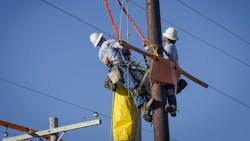Duke Energy Indiana Reaches Settlement to Modernize Grid
Duke Energy Indiana has reached a settlement with some of the state's key consumer groups on the company's plan to modernize its aging electric grid that delivers power to more than 800,000 Hoosier homes, businesses and industries.
The company reached agreement with the Indiana Office of Utility Consumer Counselor, the Duke Energy Indiana Industrial Group, Companhia Siderurgica Nacional, Steel Dynamics, Wabash Valley Power Association, Indiana Municipal Power Agency, Hoosier Energy Rural Electric Cooperative and the Environmental Defense Fund on a seven-year plan using a combination of advanced technology and infrastructure upgrades to improve service to customers.
"This plan is about creating an energy network that makes it easier for us to prevent and respond to power outages while strengthening an electric grid that has served the state for more than a century," said Duke Energy Indiana President Melody Birmingham-Byrd. "Besides replacing aging equipment, the plan modernizes the electric grid for the type of information and services that consumers have come to expect."
In May, the Indiana Utility Regulatory Commission denied Duke Energy Indiana's original plan proposed in August 2014, asking for more details and more focus on electric grid projects. In December, the company filed a revised plan addressing the commission's issues.
As part of the settlement, Duke Energy will reduce the level of capital investments recovered through the plan's customer bill tracker from approximately $1.8 billion to approximately $1.4 billion. Part of the reduction comes from $192 million earmarked for new advanced digital meters, but the company retains the ability to pursue the meters and defer their costs for consideration in a future rate case rather than through a monthly bill tracker as other items in the plan.
The company also agreed to reduce its return on equity on plan investments from 10.5 to 10 percent for investments that flow through the plan's bill tracker. This does not impact the company's 10.5 percent allowed return on equity on its other remaining investments.
Some of the plan's consumer benefits include:
- Improved power reliability and safety from updating and replacing aging electric grid infrastructure, including substations, utility poles, power lines and transformers.
- Fewer and shorter power outages where "self-healing" systems are installed. Today, when a tree or other object comes in contact with a power line causing an outage, every customer served by that line — and other lines connected to it — loses power. With self-healing technology, the company can automatically detect the problem, isolate it and reroute power — so fewer customers are affected while repairs are made.
- Improved information for consumers. Equipment such as line sensors will enable the company to provide customers more information about power outages affecting them and estimated restoration times. In some cases, the equipment can reduce the need to dispatch field personnel to find an outage's location, which speeds power restoration.
- Energy savings from grid technology that optimizes voltage and reduces overall power consumption by about 1 percent on upgraded power lines.
If the company pursues advanced meters, it agreed to explore energy efficiency pilot programs involving new meter technology.
Advanced meters have additional benefits, including fewer estimated customer bills because meters can be read automatically. There also is quicker service because some customer requests can be performed remotely through the new meters without having to wait for a technician to arrive.
Advanced meters also provide customers with greater, quicker access to information on their energy use, which can help consumers make wise energy decisions.
Approximately 40 percent of the nation already has made the transition to advanced meter technology.
The proposed settlement will need to be approved by the Indiana Utility Regulatory Commission. State regulators will set a schedule for hearings on the proposed plan and settlement. If the plan is approved, customers will see a gradual rate increase averaging 0.75 percent per year between 2017 and 2022. A decision is anticipated in mid-2016.
The company filed the plan under the provisions of Indiana Senate Enrolled Act 560, state legislation that was passed in 2013 and is aimed at improving utility infrastructure. Under the law, utilities can file a seven-year infrastructure improvement plan with state utility regulators. If approved, a utility can request recovery of 80 percent of its investment through a customer bill tracker. Recovery of the remaining 20 percent would be deferred for review until the utility's next base rate case. Under the new law, utilities must file a base rate case before the end of their seven-year plans.
